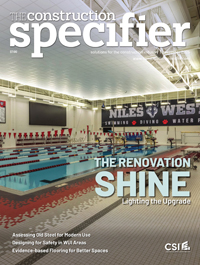Key considerations for designing fenestration systems for success
Anchoring the window through the upturned leg of the sill pan flashing back to a structural angle, which is then anchored into the slab or wall, avoids penetrating the horizontal surface and all the defenses installed there—if the window system can accommodate the alternate structural attachment. However, not all window manufacturers approve of this installation, and some systems may physically not allow for it, which is why getting the manufacturer on board is a key part of the process.
At a window wall system, horizontal penetrations are almost impossible to avoid, as noted previously; therefore, the penetrations must be sealed where they puncture the waterproofing membrane. However, anchorage should still be within the depression, which provides some protection against water flow to the interior. The horizontal penetrations at a curtain wall are less of a waterproofing concern if the transition membrane is glazed into the glazing pocket, as the anchorage happens further inboard of the weathering wet/dry zone plane.
Conclusion
Successful projects require careful consideration and detailing of the fenestration systems during the design phase. It is critical for clear performance requirements, testing standards, and safety glazing protocols to be outlined in the specifications for the best chance at a well-performing fenestration system. In addition, design teams should be aware of the challenges that may come along with foreign manufacturers, value engineering, and substitutions. Although cost savings may be attainable, this aspect should not come at the cost of compromised performance. Effective communication with clients and contractors is necessary to ensure projects meet the intended design goals.
Author

 Bradford J. Antes, PE, is a consulting engineer within the building technology division in the Simpson, Gumpertz & Heger Inc. (SGH) New York office. He is experienced in the design and investigation of new and existing building enclosure systems. He regularly collaborates with owners, architects, and contractors during design and construction of the building enclosure systems. He can be reached at bjantes@sgh.com.
Bradford J. Antes, PE, is a consulting engineer within the building technology division in the Simpson, Gumpertz & Heger Inc. (SGH) New York office. He is experienced in the design and investigation of new and existing building enclosure systems. He regularly collaborates with owners, architects, and contractors during design and construction of the building enclosure systems. He can be reached at bjantes@sgh.com. Erin E. Regan, PE, is a senior consulting engineer within the building technology division in the Simpson, Gumpertz & Heger Inc. (SGH) New York office. She focuses on building energy analysis, finite element analysis, roof design, window and curtain wall systems, and below-grade waterproofing. Regan has experience in design, investigation, rehabilitation, commissioning, and construction administration of historic and contemporary buildings. She can be reached at eeregan@sgh.com.
Erin E. Regan, PE, is a senior consulting engineer within the building technology division in the Simpson, Gumpertz & Heger Inc. (SGH) New York office. She focuses on building energy analysis, finite element analysis, roof design, window and curtain wall systems, and below-grade waterproofing. Regan has experience in design, investigation, rehabilitation, commissioning, and construction administration of historic and contemporary buildings. She can be reached at eeregan@sgh.com.






